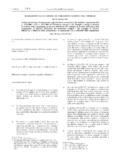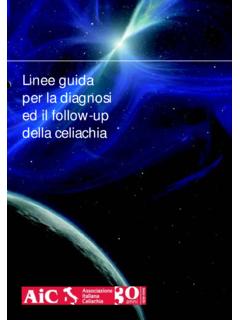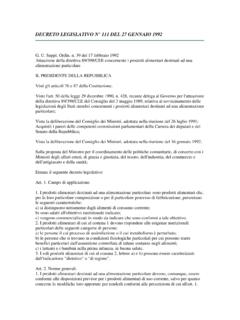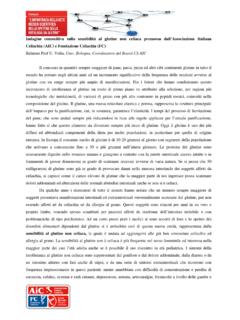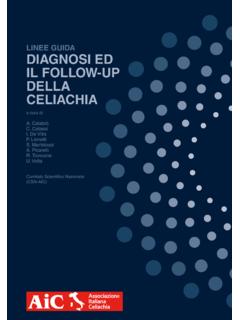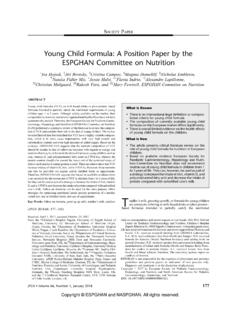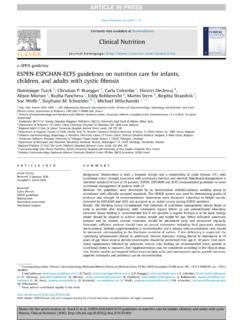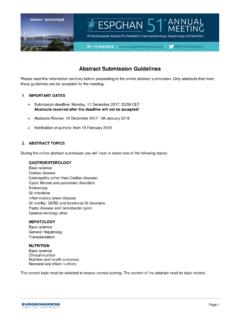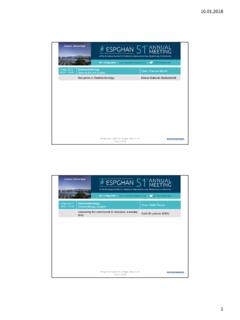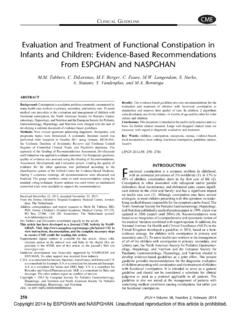Transcription of New ESPGHAN guidelines for the diagnosis of Coeliac ...
1 New ESPGHAN guidelines for the diagnosis of Coeliac disease in children and AdolescentsSteffen HusbyHans Christian Andersen children s Hospital Odense University Hospital, DenmarkAgenda Change in clinical paradigm Definitions of Coeliac disease New diagnostic guidelines Algorithms Interlaken ESPGHAN criteria (1979) intestinal biopsy: villous atrophy free diet for 1-2 : normal. of gluten : villous atrophy McNeish et al. Arch Dis Childh 1979;54:783 Revised ESPGHAN criteria intestinal biopsy: villous and serological improvement after 2-3 months No further biopsy Provided age > 2 yearsWalker Smith et al.
2 Arch Dis Child 1990;65:99 General:Puberty & growth delayMalignanciesAnemiaGI system:Diarrhea, vomitingDistension, painMalnutrition, weight lossHepatitis, cholangitisBone:Osteoporosis, fracturesArthritisDental anomaliesCNS:Ataxia, seizuresDepressionHeart:CarditisSkin & mucosa:Dermatitis herpetiformisAphtous stomatitisHair lossReproductive system:MiscarriageInfertilityModified fromRewers, Gastroenterology 2005 Celiac disease as a multiorgan autoimmune diseaseCoeliac diseaseType 1 DiabetesDermatitis herpetiformisAutoimmune hypothyroidismAdrenal antibodiesHansen et al.
3 UnpublishedPatientTowards a new definition of Coeliac disease Chronic Multi-organ Small intestinal inflammation Transglutaminase-relatedESPGHAN working group, 2011 Suggestion: New definition an immune-mediated systemic disorder elicited by gluten and related prolamines in genetically (mainly HLA) susceptible individuals characterized by a combination of: gluten dependent clinical manifestations anti-tissue transglutaminase (TG2) antibodies enteropathy Husby et al. JPGN 2012 ESPGHAN classification Silent CD:positive CD antibodies and biopsy findings, not sufficient symptoms to warrant clinical suspicion of CD Latent CD: positive CD antibodies, no villous atrophy.
4 The patient has had a gluten-dependent enteropathy. Patient may/may not have symptoms Potential CD: positive antibodies, but no villous atrophy. Patient may/may not have symptoms. CD may or may not developThe Oslo Definitions Coeliac disease is a chronic small intestinal immune-mediated enteropathy precipitated by exposure to dietary gluten in genetically predisposed individuals. Discourage the use of classical vs. non-classical, typical vs. atypical Discourage the use of the term latent CDLudvigsson et al. Gut 201285 % of those who are compliant to the 1990 criteria want them to be changed challenge policy: 100 % HLA should be included for DX 80%ESGPHAN member et al.
5 JPGN 2012 Previous evidence-based guidelines for CD diagnosis AHRQ (USA, 2004) Adults and children NICE guidelines (UK, 2009) Adults and children For GP s and general paediatricians None questioned the biopsyRostom A, et Celiac disease . EvidenceReport/ Technology Assessment No. 104. AHRQ Publication No. 04-E029-2, 2004 NICE Clinical guidelines 86. Coeliac disease : Recognition and assessment of Coeliac disease . UK, May 2009 guidelines : AHRQ (USA, 2004) of serological / incidence of CD associated of testing for for adherence to a gluten-free and specificity of EMA and TG2 ab quite common, prevalence in the general population likely close to 1 in Coeliac societies improves compliance with a GFDR ostom A, et Celiac disease .
6 EvidenceReport/Technology Assessment No. 104. AHRQ Publication No. 04 E029 2, 2004 Main issuesConclusionsEvidence-based criteria for clinical an answerable down the best evidence appraise the evidence for Validity Impact (size of the benefit) with clinical expertise and patient our effectiveness and efficiency keep a record/improve the processEvidence-based medicinePatient preferencesand valuesDevereaux 2004 Clinical circumstancesLiterature searchSearch 1: n=1,418 EMBASE, 2: n= 3: n=778 Embase ,598 Entering Level 1 screeningn=2,242 + 22 no full textexcludedn=334 Full textEntering Level 2 screeningn=247excludedn=87 Entering Level 3 screeningn = 16 publicationsIncluded in data synthesisN = 71 excluded based on E1-8:No biopsyAgeQuality et al.
7 2010 Grading EvidenceType of study: DiagnosisStudy QualityLevel 1: Good quality patient-oriented evidence Validated clinical decision rule Systematic Review(SR)/meta-analysis of high quality studies High quality diagnostic cohort studyLevel 2: Limited quality patient-oriented evidence Unvalidated clinical decision rule SR/meta-analysis of lower qualitystudies or studies Lower quality diagnostic cohort studyor diagnostic case control studyLevel 3: Other evidenceConsensus guidelines , extrapolations from bench research, usual practice, opinion, disease -oriented evidence, case series MH et al.
8 JABFP 2004 Example statement: Increased prevalence of CD in children with Type 1 diabetes 2 12 Down s syndrome 5-12 Autoimmune thyroid disease up to 7 Turner syndrome 2-5 Williams syndrome up to 9 IgA deficiency 2-8 Autoimmune liver disease 12-13 First degree relatives with CD 10-20%Recommendation: ( ) offer testing for CD of children and adolescents with the following conditions: Type 1 diabetes Down s syndrome Autoimmune thyroid disease Turner syndrome Williams syndrome IgA deficiency Autoimmune liver disease 1st degree relatives with CDCoeliac Antibodies IgA Anti-TG2 antibody IgA Endomysial antibody (EMA) IgA and IgG Deamidated Gliadin Peptide (DPG) antibody NOT: IgA and IgG anti-gliadin antibodiesDISEASE PREDICTION BY ANTIBODIES(pooled estimates with 95% confidence values.)
9 Indicates high hetereog neity)Positive likelihood ratioNegative likelihood ratioOdd sratioEMA ( ) ( )553(218-1402)Anti-TG2 ( ) ( )469 (250-880)Anti-DGP ( ) ( )234(100-546)Anti-DGP ( ) ( ) (56-132)AGA ( ) ( ) (14-117)Giersiepen, Evidence report, JPGN 20121994200136543644 Diagnosedceliac: 010361727M ki, N Engl J Med 20031 of symptomatic Coeliac disease in EMA positive subjectsPredictive values for TG2 antibodyPositive predict. valueToftedal et al. JCLM 201010100100010203040 Aesku 135 Site Luminex 43 DiaSorin 57 Euroimmun 200 * 95 Assays 89 69 * ELIA
10 ImmunoCAP Varelisa in Varelisa [Celikey]Median ELISA values in 14 commercial anti-TG2 assays(data kindly provided by UK NEQAS)AU High sample xULN*logarithmic assaysChild / adolescent with Symptoms suggestive of CDAnti-TG2 IgA & total IgA*Anti-TG2positiveNot CDTransfer to Paediatric GIPaed. GI discusses with family the 2 diagnostic pathways and consequences considering patient s history & anti-TG2 titersConsider further diagnostic testing if:IgA deficiencyAge: < 2 yearsHistory: - low gluten intake- drug pretreatment- severe symptoms- associated diseasesAnti-TG2 > 10 x normalAnti-TG2 < 10 x normalEMA & HLA DQ8/DQ2 EMA availableOEGD & biopsiesAnti-TG2negativeEMA 0-1 Marsh 2 or 3 Consider false neg.
